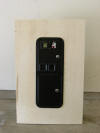ArcadeCab
Cabinet Plans 2: The Door
Table of contents
- Background
- Tools
- Materials
- Cutting Side One
- Cutting Side Two
- Dado for the Base
- Building the Base
- Monitor Shelf
- Ledger Boards
- Speaker Area- Start
- Upper rear
- Back
- Top
- Drawer
- Door
- Speaker Area- Cuts
- Painting
- Assembly
- Marquee
- Monitor Bezel
- List of Boards
- Control Panel Part 1
- Control Panel Part 2
- Wiring the CP
- Attaching the CP
- Finishing Touches
- Software
- Final Thoughts
The Door
The next step to conquer is the
front door, with the coin door cutout. Start by cutting out a
board 30-3/4" long x 19-3/4" wide. We are allowing 1/4" gap for
the hinges.
 Once you have that cut out (as in B), you are
ready to draw out the coin door cutout. Scott
bought the Happ Over/Under Coin Door (see left) so we hit
Happ's site for the cutout diagram. In case the link
changes, I have included the important information to the right.
Once you have that cut out (as in B), you are
ready to draw out the coin door cutout. Scott
bought the Happ Over/Under Coin Door (see left) so we hit
Happ's site for the cutout diagram. In case the link
changes, I have included the important information to the right.
Without going into too much detail, I essentially centered the cutout on the door face. Picture D shows it all drawn out, with plenty of guidelines. I then used a 5/8" spade bit (you could use any bit large enough) at each corner so I could get the jigsaw blade through the panel (see E). I then cut out the hole with the jigsaw, taking my time to stay on the line. Be careful with the rounded corners. Keep your cut to the inside of the curve or else you may leave a cut that is visible from outside the door.
Now is the moment of truth. Place the coin door into the hole and hope it fits properly. As it happened, one corner was not rounded enough and you could see daylight through it when the coin door was in place. Hence, the note at the end of the previous paragraph. However, because the cutout was centered, I tried flipping it around. That worked and the fit was perfect. Whew!
Stand the door up and admire your work. Mounting
the door and installing the door lock will have to wait until the
cabinet has been painted and assembled.
Additional info: The coin door that Scott purchased
came standard with yellow coin reject buttons on it. Yellow did
not fit Scott's cabinet design so we ordered two replacement buttons in
blue. They are part #42-0517-02 Blue reject button assembly on
Happ's site.
In addition, Scott is going to use tokens, not quarters, to plug the
machine with. Therefore, he designed
some custom "push to reject" art for them. He designed them as 1 inch
tall by 3/4" wide to fit perfectly. Scott has graciously provided
them for your use below.
The next page revisits the speaker area where we will cut out the speaker holes.









